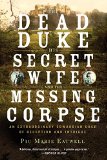Summary | Excerpt | Reviews | Beyond the Book | Readalikes | Genres & Themes | Author Bio
An Extraordinary Edwardian Case of Deception and Intrigue

Critics' Opinion:
Readers' Opinion:
First Published:
Oct 2015, 352 pages
Paperback:
Sep 2016, 352 pages
 Book Reviewed by:
Book Reviewed by:
Kim Kovacs
Buy This Book
SCENE ONE
Welbeck Abbey
December 1879
Eccentric men have peculiar habits; they do not seem to move in the same sphere with other mortals, but are actuated by different influences from those which affect the bulk of mankind.
GEORGE FREDERICK GRAHAM
English Synonyms Classified and Explained (1857)
It was a dark, windy winter evening a few days before Christmas 1879. The occupants of the saloon carriage of the train of the Great Central Railway Company that rattled from King's Cross Station in the direction of Sheffield were tense and silent. In the carriage sat a young man of twenty-two. He was pale, with a high forehead and heavily hooded eyes. Also in the carriage sat five other people: two younger men, a sickly boy, a pensive and alert-looking little girl of six years old, and an older woman who regarded the other occupants with anxious attention. All the party were dressed in sombre black, the garb of deep mourning. Every so often, the countryside bordering the line would light up as the train approached a town: Luton, Northampton, Leicester or Nottingham. In the wells of shadow in between, nothing was discernible from the carriage window, save – as the train toiled further north – the dark mass of Sherwood Forest.
After about three hours, the train came to a screeching halt at the small station of Worksop, about fifteen miles from Sheffield. Worksop Station was a newish building constructed some thirty years previously for the Great Central Railway Company (then known as the Manchester, Sheffield and Lincolnshire Railway). It was a somewhat preposterous affair, with its mock-Jacobean pinnacles, rustications, scrolls, scraps, lozenges and other whatnots. A small market town for much of its history, Worksop had seen a burst of growth with the construction of the Chesterfield Canal in 1777 and the arrival of the railway in 1849, both of which ran through the settlement. The discovery of a sizeable coal seam had brought a rush of new inhabitants to what had been a sleepy country town, nestled in the shadow of Sherwood Forest.
Other occupants of the train might have been surprised to see the saloon carriage party – who were clearly of a well-to-do sort – descend at such a humble spot as Worksop. Nevertheless, it appeared that they were expected, as an inquisitive crowd enveloped the group as soon as they emerged from the train, their white faces and dark clothes catching the light of the oil lamps as they made their way across the platform to the old-fashioned carriage that awaited them. 'The young duke! Did you see him?' was the excited whisper that went round.
After a long and dreary drive through wet country lanes, the party that included the 'young duke' – for that was the identity of the pale and heavy-eyed young man of twenty-two – arrived at its destination. Welbeck Abbey, like the nearby town of Worksop, was situated near the northern end of Sherwood Forest. The area was known as 'the Dukeries' – there being no fewer than four ducal seats within a few miles' radius. Welbeck Abbey had been the principal seat of the Dukes of Portland since 1809, but by 1879 there was little to be found of the original 'Abbey', apart from the name. The abbey had been founded as the chief seat of the white--cassocked -Premonstratensian monastic Order in the twelfth century. During the Dissolution, the house had been handed by Henry VIII to his prominent administrator, Richard Whalley of Screveton. Afterwards, it had passed to -Whalley's son, then through a series of sales and transfers to Lord Talbot, heir to the Earl of Shrewsbury, and finally in 1607 to Sir Charles Cavendish, a son of one of the best-known figures of the Elizabethan age, Bess of Hardwick.
Bess was a friend of Queen Elizabeth I, but while she shared many of her characteristics – including her first name and shrewd personality – she did not, like her, live and die a maiden. Quite to the contrary; by the end of her career, she had married no fewer than four times, and accumulated a fortune in landed estates across the country. She was also, by her many marriages and complex network of family connections, a remote ancestor of most of England's nobility, and even boasted royal connections.
Excerpted from The Dead Duke, His Secret Wife, and the Missing Corpse by Piu Marie Eatwell. Copyright © 2015 by Piu Marie Eatwell. Excerpted by permission of Liveright / WW Norton. All rights reserved. No part of this excerpt may be reproduced or reprinted without permission in writing from the publisher.





The House on Biscayne Bay
by Chanel Cleeton
As death stalks a gothic mansion in Miami, the lives of two women intertwine as the past and present collide.

The Flower Sisters
by Michelle Collins Anderson
From the new Fannie Flagg of the Ozarks, a richly-woven story of family, forgiveness, and reinvention.

The Funeral Cryer by Wenyan Lu
Debut novelist Wenyan Lu brings us this witty yet profound story about one woman's midlife reawakening in contemporary rural China.
Your guide toexceptional books
BookBrowse seeks out and recommends the best in contemporary fiction and nonfiction—books that not only engage and entertain but also deepen our understanding of ourselves and the world around us.